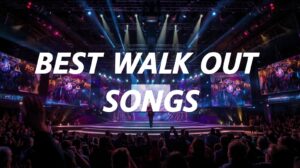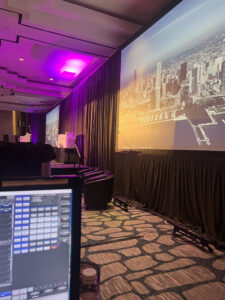Corporate events in 2025 look nothing like they did a few years ago. The way companies plan, host, and measure success has changed drastically, and it’s still evolving.
Adapting to the latest corporate trends in 2025 isn’t about following buzzwords. It’s about staying relevant, making smarter decisions, and creating experiences that people actually care about. Looking to align your next event with these trends? Check out our AV production services for corporate event production in Atlanta, built to deliver modern and engaging experiences.
Here’s a clear look at the top 10 corporate event trends for 2025 and how to apply them without overcomplicating the process.
1. Hybrid Event Isn’t Going Anywhere
Hybrid events are now a part of corporate events. Companies see the value in combining in-person and virtual elements. It cuts travel costs and allows people across different time zones to join. Executives and attendees alike want flexibility. Hybrid formats offer exactly that with flexible access, scalable reach, and lower overhead.
The goal isn’t to replace in-person connections. Instead, it’s about giving options. Attendees decide how they want to engage. Whether tuning in live or catching replays, participation happens on their terms.
2. Use of Advanced Technology (AI and Virtual Reality)
AI and VR are shaping how businesses host events. AI helps personalize the attendee journey. From registration to session recommendations, it predicts what guests want based on behavior.
VR transports attendees into immersive environments. Think virtual product demos or remote facility tours. These experiences keep people interested. They also remove geographic limitations.
Chatbots, facial recognition check-ins, and smart schedules powered by AI also save time and reduce errors.
3. Sustainable Event Planning
Green practices are more than just a checkbox. In 2025, brands are expected to reduce waste, use local vendors, and cut down energy use. Planners are ditching plastic, using digital handouts, and partnering with eco-certified venues.
Vendors offering reusable materials and low-emission transport options are now preferred. Even menu planning focuses on locally sourced food.
Events that leave a lighter footprint win favor with environmentally conscious businesses and attendees.
4. Micro-Events for Targeted Networking
Smaller, more focused gatherings are on the rise in 2025. Instead of packing a convention hall, companies are organizing niche events with hand-picked guests.
These micro-events improve connection. With fewer people, discussions run deeper. Networking becomes more personal. Brands use these settings to foster loyalty and have honest conversations.
They’re also easier to plan, manage, and budget, especially useful for companies trying to show value without hosting massive conferences.
5. Employee Well-Being and Wellness-Focused Events
Events are being built around mental and physical wellness. Companies know that burned-out employees won’t engage. Sessions now include stress-relief activities, healthy meals, and wellness breaks.
Some events feature guided meditation, on-site massage therapy, or movement sessions between panels.
The shift proves that productivity and well-being can go hand-in-hand. It’s no longer about keeping people busy, it’s about keeping them balanced.
6. Gamification for Increased Engagement
Event organizers are using gamification to keep energy levels up. Point systems, challenges, and live leaderboards create friendly competition. It works for both virtual and in-person formats.
Gamified networking, scavenger hunts, and reward-based learning activities give attendees a reason to stay engaged. Even keynote sessions sometimes include interactive quizzes or polls with prizes.
This approach works especially well in corporate training and team-building events. It breaks monotony and adds excitement.
7. Data-Driven Event Planning and Analytics
Planning without data is over. Event software now tracks everything from attendance patterns to feedback scores. It helps organizers understand what worked and what didn’t.
Real-time data during events lets planners make quick fixes. Post-event analytics highlight what to improve next time. AI even analyzes attendee engagement to recommend future topics or formats.
This kind of insight leads to better ROI and more meaningful attendee experiences.
8. Higher Safety Measures During Events
Safety isn’t just a trend, it’s a baseline. Attendees expect visible health and security measures. Sanitization stations, air filtration systems, and medical staff on standby are now standard.
Generally, corporate event safety embraces three aspects:
- Physical safety.
- Psychological safety.
- Online safety.
Digital check-ins reduce queues. Some companies use wearable tech to manage crowd density or contact tracing. These features help attendees feel safe and confident.
Security protocols are also tighter, especially for high-profile corporate events. Event planners must plan for both health and cyber threats.
9. Accessibility and Inclusivity in Business Events
Accessibility is now a priority. Businesses are removing physical and digital barriers that exclude people. This includes closed captioning, sign language interpretation, wheelchair access, and sensory-friendly environments.
Event apps are built with screen readers in mind. Registration forms include gender-neutral language. Marketing materials reflect diverse audiences.
Companies that ignore this lose credibility. Those who lead with inclusion send a clear message: everyone belongs.
10. Unique Venue Selection
Standard hotel ballrooms aren’t cutting it anymore. Brands are choosing unusual venues rooftop gardens, art galleries, industrial warehouses, or even historic buildings.
Unique spaces create memorable experiences. They also align better with brand identity. The setting can speak just as loudly as the speaker.
Venue selection now takes into account natural lighting, acoustics, layout flexibility, and visual appeal. These choices influence how attendees remember the event and how they talk about it afterward.
Conclusion
Corporate events are evolving fast in 2025, and keeping up with the latest trends makes all the difference. Whether it’s using cutting-edge technology or focusing on attendee well-being, these changes shape memorable experiences.
Huview Production is an Atlanta-based audio visual production company committed to helping businesses deliver events that impress and inspire. When you want your next event to reflect what’s current and effective, our team is ready to bring your vision to life.







